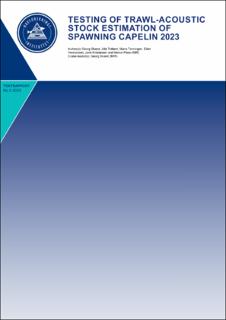| dc.contributor.author | Skaret, Georg | |
| dc.contributor.author | Totland, Atle | |
| dc.contributor.author | Tenningen, Maria | |
| dc.contributor.author | Hermansen, Eilert | |
| dc.contributor.author | Kristiansen, Jarle A | |
| dc.contributor.author | Pena, Hector | |
| dc.date.accessioned | 2023-05-05T10:46:55Z | |
| dc.date.available | 2023-05-05T10:46:55Z | |
| dc.date.created | 2023-05-04T14:13:21Z | |
| dc.date.issued | 2023 | |
| dc.identifier.uri | https://hdl.handle.net/11250/3066423 | |
| dc.description.abstract | This report describes the fifth in a series of trawl-acoustic monitoring surveys of the maturing stock of capelin during the spawning migration to the coast. The survey is a response to a proposal from the industry to evaluate the possibility of using winter monitoring of maturing capelin as an input to the capelin assessment and advice. The timing and geographic coverage of the survey are such that they would be relevant to use for advice given that the output is reliable. The rental of the vessel was this year funded by the Norwegian Fishermen’s Sales Organization for Pelagic Fish. Pre-defined areas off the Troms and Finnmark coast were covered using FV Vendla. A stratified random transect design was adopted with a zig-zag transect grid covered in west-east direction over 6 strata. Echo sounders with frequencies from 18-333 kHz were run together with a low frequency ST90 sonar, and target trawls were carried out on significant pelagic aggregations. Capelin abundance was estimated using 38 kHz data. The total biomass of maturing capelin in the coverage area was estimated at 274 732 tons, with a CV of 35%. The 5% lower and 95% upper confidence limits were 128 879 and 448 768 tons, respectively. The confidence bands overlap with the uncertainty intervals in the prediction from the autumn 2022, but on the low side. Capelin recorded in the stratum covering the coast from Hjelmsøy to Nordkyn dominated in the estimate (strata 3 and 4). Ca. 86% of the total biomass was found in these two strata, and ca. 78% of the schools detected with sonar. Sonar data showed that the capelin schools in these easterly areas in general moved in a westerly direction. Very little capelin was recorded in the west and in the Varangerfjord. Age 4 capelin (2019 year class) totally dominated the sampled capelin. Mean length of the capelin was 16.03 cm, mean weight 20.3 g, and mean roe percentage was 16 with no temporal or geographical trend, but maturation had extended further close to the coast than off the coast. The abnormal low frequency response at 38 kHz observed in some of the earlier survey years, was not observed to any large extent this year. This is the fifth year that the estimate from this survey shows consistency with the estimate from the autumn survey. This is promising for the use of the survey results for advice, but it was obvious that there were maturing capelin that had not been covered, in particular in the Russian EEZ where the Russian vessels were fishing. The results from the 4 previous survey years were evaluated in a recent ICES capelin benchmark meeting in November last year, but the report from the meeting was not published by the time of the release of the present report. | |
| dc.description.abstract | Testing of trawl-acoustic stock estimation of spawning capelin 2023 | |
| dc.language.iso | eng | en_US |
| dc.publisher | Havforskningsinstituttet | en_US |
| dc.relation.ispartof | Toktrapport | |
| dc.relation.ispartofseries | Toktrapport;2023 - 5 | |
| dc.relation.uri | https://www.hi.no/hi/nettrapporter/toktrapport-en-2023-5 | |
| dc.title | Testing of trawl-acoustic stock estimation of spawning capelin 2023 | en_US |
| dc.title.alternative | Testing of trawl-acoustic stock estimation of spawning capelin 2023 | en_US |
| dc.type | Research report | en_US |
| dc.description.version | publishedVersion | |
| dc.source.pagenumber | 31 | en_US |
| dc.source.issue | 2023 - 5 | en_US |
| dc.identifier.cristin | 2145550 | |
| dc.relation.project | Havforskningsinstituttet: 15568-01 | |
| cristin.ispublished | true | |
| cristin.fulltext | original | |
